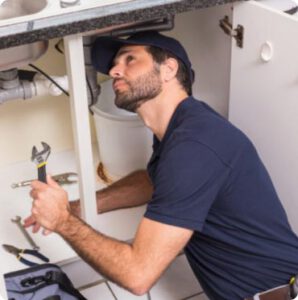
Garbage disposals typically leak from three spots: the top, the bottom or the pipe connections. How do you know if you have a leak? Just check each place, using a flashlight to look for puddling, condensation and other signs of water accumulation until you determine the source. A professional can help with this common plumbingtask if you are unsure of where to look. They can also perform the repair quickly and effectively without damaging the unit itself or the sink.
Usually, it’s a minor part that’s just loose or worn out. When you know the source of your garbage disposal leak, you are better able to determine how to fix it.
Signs of a Leaking Garbage Disposal
Check for obvious signs first. First, take a look under the sink for puddling water, dripping, dampness, or a musty odor. If you see leaks, double check to ensure the sink itself isn’t leaking, or that the p-trap isn’t leaking.
Turn off the disposal, unplugging it completely, then start filling up the sink with water to halfway. Add some food coloring to the water so you can more easily spot the leak.
Finding the Source
Garbage disposals generally start leaking from four different places:
- Sink flange: This is at the top of the disposal unit, and connects the disposal to the sink top. This is held into place by putty and bolts. Sometimes the putty has deteriorated or the bolts have rusted or loosened, making the watertight seal start to leak.
- Dishwasher hose connection:This ison the side of the disposal and it’s where the flexible plastic dishwasher hose is connected to the unit. This often leaks when the screws holding it to the unit have become loose due to rust, time or excessive jostling.
- Drain line connection: This is also located on the side, and it’s where the main drain pipe is connected to the disposal via curving PVC or metal pipes. This may be leaking because the screws that secure it to the disposal have become worn out, or the rubber gasket in the mounting assembly is leaking.
- Reset button: This ison the bottom of the disposal, and can deactivate the disposal if it jams or has an overloaded motor. Leaks originating from here mean that a seal inside the unit has worn out. This happens with age, and may indicate the need for a new seal or a whole new unit if it’s very old.
Whether you know where the leak is coming from and prefer to a have a plumber make the repair, or haven’t a clue where the leak is originating from in the first place, it’s always wise to call a professional.
Contact Tidal Plumbing and Heating
Got garbage disposal concerns? Don’t hesitate to contact usto book a convenient appointment in NYC at 718-505-9300.
